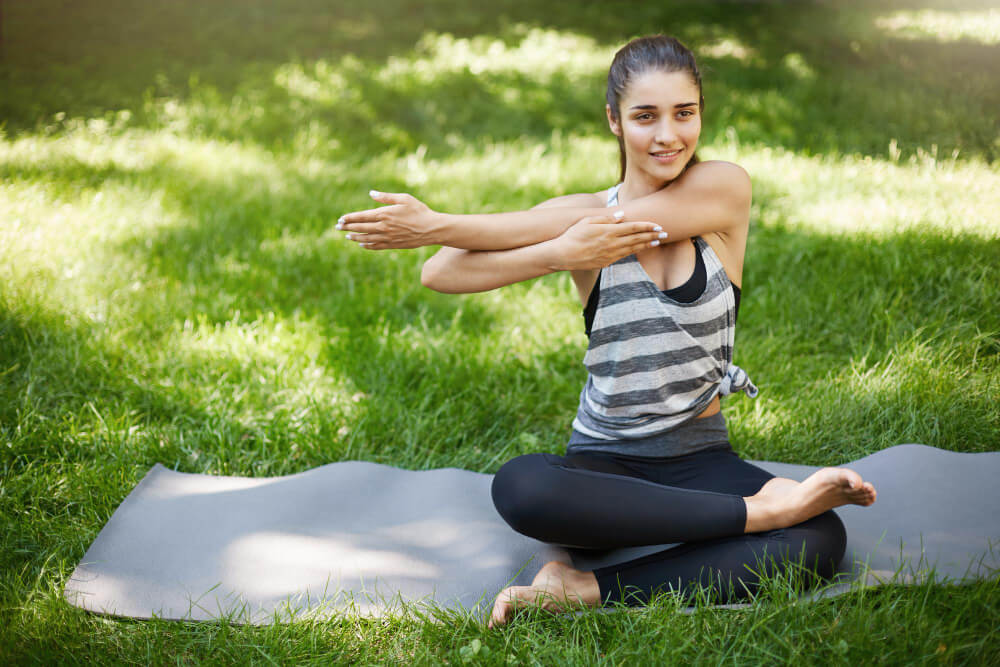Heartfelt Healing: Harnessing the Power of Yoga for Heart Health
Heart health is paramount for overall well-being, serving as the foundation for a vibrant and fulfilling life. In recent years, […]

Heart health is paramount for overall well-being, serving as the foundation for a vibrant and fulfilling life. In recent years, the integration of yoga for heart health management has garnered significant attention, offering a holistic approach that addresses the physical, mental, and emotional aspects of cardiovascular wellness. As we delve deeper into understanding the intricate connection between yoga and heart health, it becomes evident that this ancient practice holds immense potential for enhancing cardiovascular fitness, reducing the risk of heart disease, and promoting overall well-being.
Understanding Heart Health
Heart disease encompasses a spectrum of conditions, including coronary artery disease, hypertension, arrhythmias, and heart failure. Each condition presents unique challenges and risks, necessitating tailored approaches to prevention, management, and treatment. By gaining a comprehensive understanding of these conditions, individuals can make informed decisions regarding their heart health and take proactive steps towards mitigating the risk of cardiovascular events.
Risk Factors for Heart Disease
Numerous factors contribute to the development of heart disease, including genetics, poor dietary choices, physical inactivity, smoking, excessive alcohol consumption, obesity, high blood pressure, and unmanaged stress. Identifying and addressing these risk factors is crucial for mitigating the risk of cardiovascular events and promoting heart health. By adopting healthy lifestyle habits and making positive changes to diet, exercise, and stress management, individuals can significantly reduce their risk of heart disease and improve overall well-being.
The Connection Between Yoga and Heart Health
Benefits to the Cardiovascular System
Yoga offers a myriad of benefits for heart health, exerting positive effects on the cardiovascular system through various mechanisms. Physical postures (asanas) enhance circulation, improve flexibility, and strengthen the heart muscle, while breath control (pranayama) regulates heart rate and blood pressure, and meditation fosters relaxation and reduces stress. These components of yoga work synergistically to promote cardiovascular wellness and support overall well-being.
Research Studies Supporting Yoga’s Benefits
A growing body of scientific research supports the therapeutic benefits of yoga for heart health. Studies have shown that regular yoga practice can lower blood pressure, cholesterol levels, and inflammatory markers, improve cardiac function, endothelial health, and autonomic balance, and reduce the risk of cardiovascular events such as heart attacks and strokes. By providing evidence-based validation of yoga’s effectiveness in promoting heart health, these studies underscore the importance of integrating yoga into comprehensive heart disease prevention and management programs.
Lifestyle Tips for a Healthy Heart
A. Balanced Diet
A heart-healthy diet emphasizes whole foods rich in fruits, vegetables, whole grains, lean proteins, and healthy fats, while minimizing processed foods, sugar, sodium, and saturated fats. By nourishing the body with nutrient-dense foods that support heart health, individuals can optimize cardiovascular wellness, maintain a healthy weight, and reduce the risk of heart disease and related complications.
B. Regular Exercise
Regular physical activity is essential for maintaining heart health, promoting cardiovascular fitness, and reducing the risk of heart disease. Aim for at least 150 minutes of moderate-intensity exercise or 75 minutes of vigorous-intensity exercise per week, supplemented with muscle-strengthening activities on two or more days per week. By incorporating aerobic exercise, strength training, and flexibility exercises into daily routines, individuals can improve heart function, increase energy levels, and enhance overall well-being.
C. Stress Management
Chronic stress can negatively impact heart health by contributing to high blood pressure, inflammation, and poor lifestyle choices. Incorporating stress-reducing practices such as mindfulness meditation, deep breathing exercises, yoga, tai chi, and progressive muscle relaxation promotes relaxation, resilience, and emotional well-being, thereby supporting heart health and enhancing overall quality of life.
D. Complementary Practices
In addition to yoga, other complementary practices such as acupuncture, massage therapy, aromatherapy, and herbal medicine can support heart health by reducing stress, improving circulation, and enhancing overall wellness. Consult with qualified healthcare professionals to explore safe and effective complementary therapies tailored to individual needs and preferences, and integrate these practices into comprehensive heart disease prevention and management plans.
Top 10 Yoga Poses for Heart Health
1. Mountain Pose (Tadasana)
Stand tall with feet hip-width apart, grounding firmly into the earth. Lift your arms overhead with palms facing each other. Engage your core and lengthen your spine, opening the heart center. Hold the pose for 5-10 breaths, focusing on deep inhalations and exhalations.
Method
Stand tall with feet hip-width apart, toes spread wide. Engage thighs, lift kneecaps, and tuck tailbone. Roll shoulders back, elongate the spine, and reach arms overhead with palms facing each other.Benefits
Improves posture, circulation, and lung capacity. Strengthens the heart muscle and promotes overall stability and balance.2. Downward-Facing Dog (Adho Mukha Svanasana)
Begin on your hands and knees, then lift your hips towards the ceiling, forming an inverted V-shape with your body. Press your palms and heels into the ground, elongating your spine. This pose stretches the chest, shoulders, and hamstrings while promoting circulation to the heart and lungs.
Method
Start on hands and knees, tuck toes, and lift hips towards the ceiling. Press palms and heels into the ground, straighten arms and legs, and lengthen through the spine. Keep head between arms and heels reaching towards the floor.Benefits
Relieves stress, stretches the spine, and promotes circulation to the heart and lungs. Strengthens arms, shoulders, and legs.3. Bridge Pose (Setu Bandhasana)
Lie on your back with knees bent and feet hip-width apart. Press into your feet to lift your hips off the mat while keeping your shoulders grounded. Interlace your fingers beneath your back and draw your shoulder blades together, opening the chest. Hold the pose for 5-10 breaths, focusing on deep inhales and exhales.
Method
Lie on your back with knees bent and feet hip-width apart. Press feet into the mat, lift hips towards the ceiling, and interlace fingers beneath the body. Roll shoulders back and press arms and shoulders into the ground.Benefits
Opens the chest, strengthens the back, and improves cardiovascular endurance. Stretches the spine and hip flexors, and stimulates the thyroid gland.4. Corpse Pose (Savasana)
Lie flat on your back with arms by your sides and palms facing up. Close your eyes and relax your entire body, allowing gravity to release any tension. Focus on deepening your breath and surrendering to the present moment. Savasana promotes deep relaxation, reduces stress, and calms the nervous system, supporting heart health and overall well-being.
Method
Lie on your back with arms by your sides, palms facing up. Close your eyes, soften the body, and relax completely. Focus on deep, rhythmic breathing and allow tension to release with each exhale.Benefits
Promotes deep relaxation, reduces stress, and calms the nervous system. Lowers blood pressure, heart rate, and cortisol levels, fostering a sense of peace and tranquility.5. Child’s Pose (Balasana)
Begin on your hands and knees, then sit back on your heels, lowering your forehead to the ground. Extend your arms in front of you or rest them alongside your body. Allow your chest to melt towards the earth, releasing any tension in the shoulders and upper back. This gentle forward fold promotes relaxation and helps alleviate stress and anxiety.
Method
Kneel on the mat, sit back on your heels, and fold forward, extending arms in front of you or alongside the body. Rest forehead on the mat, relax neck and shoulders, and breathe deeply into the back body.Benefits
Relieves tension in the back, neck, and shoulders. Calms the mind, soothes the nervous system, and promotes relaxation. Stretches the hips, thighs, and ankles.6. Warrior Pose (Virabhadrasana)
Start in a standing position, then step your right foot back into a lunge, keeping your left knee bent at a 90-degree angle. Extend your arms overhead, reaching towards the sky, and square your hips towards the front of the mat. Press into your feet and lift through the chest, opening the heart center. Hold the pose for several breaths, then switch sides.
Method
Step one foot back and bend the front knee to a 90-degree angle. Square hips and shoulders to the front, reach arms overhead, and gaze forward. Press back foot into the ground and engage core muscles.Benefits
Builds strength in the legs, arms, and core. Increases circulation and energizes the body. Cultivates mental focus, determination, and confidence.7. Triangle Pose (Trikonasana)
Begin in a standing position, then step your feet wide apart. Turn your right foot out 90 degrees and your left foot slightly inward. Extend your arms parallel to the ground, then hinge at the hips and reach your right hand towards your right foot, placing it on your shin or a block. Extend your left arm towards the sky, opening the chest and creating a straight line from fingertips to fingertips. Hold the pose for several breaths, then switch sides.
Method
Stand with feet wide apart, turn one foot out and extend arms parallel to the ground. Reach towards the extended foot, hinge at the hip, and lower hand to shin, ankle, or floor. Extend opposite arm towards the ceiling and gaze up.Benefits
Stretches the hamstrings, hips, and groins. Opens the chest and shoulders, improves digestion, and stimulates abdominal organs. Enhances balance, stability, and concentration.8. Fish Pose (Matsyasana)
Lie on your back with legs extended and arms resting alongside your body. Press your forearms and elbows into the ground as you lift your chest towards the sky. Arch your back and tilt your head back, allowing the crown of your head to rest lightly on the mat. This pose expands the chest, stretches the throat, and stimulates the thyroid gland, promoting heart health and respiratory function.
Method
Lie on your back with legs extended and arms by your sides. Press forearms and elbows into the ground, lift chest towards the ceiling, and arch back. Tilt head back and rest crown of the head on the ground.Benefits
Opens the chest and throat, stretches the front body, and expands lung capacity. Relieves tension in the neck and shoulders, stimulates the thyroid gland, and improves posture.9. Camel Pose (Ustrasana)
Kneel on the mat with knees hip-width apart, then place your hands on your lower back for support. Inhale as you lift your chest towards the sky, arching your back and reaching your hands towards your heels. Keep your hips stacked over your knees and engage your core for stability. Hold the pose for several breaths, then release slowly with control.
Method
Kneel on the mat with knees hip-width apart. Place hands on lower back, fingers pointing down. Press hips forward, arch back, and reach hands towards heels. Keep chest lifted, gaze up, and engage thighs.Benefits
Stretches the entire front body, including chest, abdomen, and quadriceps. Improves spinal flexibility, strengthens back muscles, and stimulates abdominal organs.10. Cow Pose (Bitilasana) / Cat Pose (Marjaryasana)
Begin on your hands and knees, with wrists directly under shoulders and knees under hips. Inhale as you arch your back, dropping your belly towards the mat and lifting your gaze towards the sky (Cow Pose). Exhale as you round your spine, tucking your chin to your chest and drawing your belly button towards your spine (Cat Pose). Flow between these two poses, synchronizing movement with breath to warm up the spine and increase circulation to the heart.
Method (Cow Pose)
Begin on hands and knees with wrists under shoulders and knees under hips. Inhale, arch the back, and lift the chest towards the ceiling. Allow the belly to drop towards the floor.Method (Cat Pose)
Exhale, round the spine, and tuck chin towards chest. Draw belly button towards the spine and press hands and knees into the ground.Benefits
Cow pose stretches the front body, chest, and abdomen, while cat pose stretches the back body and spine. Alternating between the two poses promotes flexibility, spinal health, and relaxation.Conclusion
In conclusion, yoga offers a holistic approach to heart health that addresses physical, mental, and emotional factors influencing cardiovascular wellness. By incorporating yoga into a heart-healthy lifestyle and embracing mindful living, individuals can cultivate resilience, vitality, and well-being, nurturing the heart and fostering a life of radiant health and vitality. With dedication, commitment, and practice, yoga becomes not only a tool for promoting heart health but also a path to self-discovery, transformation, and inner peace. Visit our YouTube channel to find out more information on yoga and meditation.

 Hollif
Hollif 
































